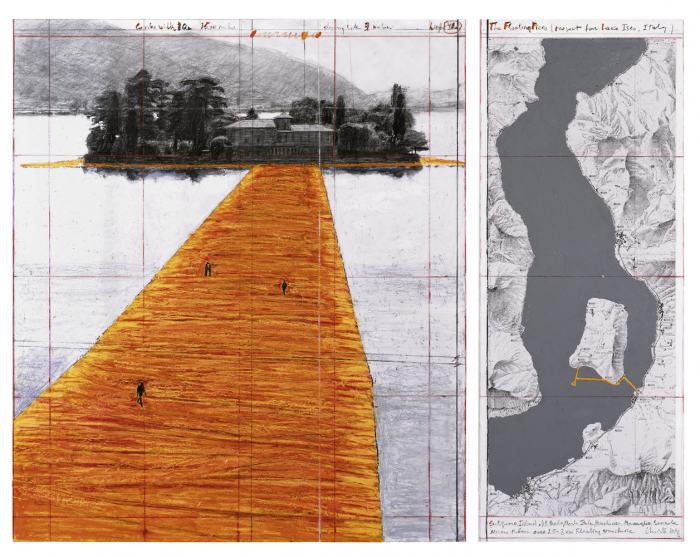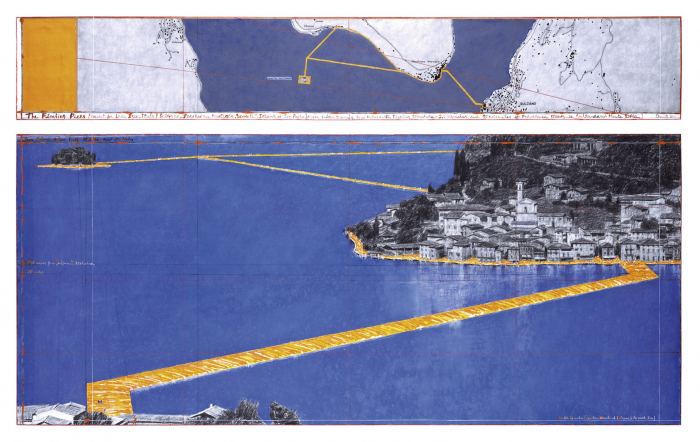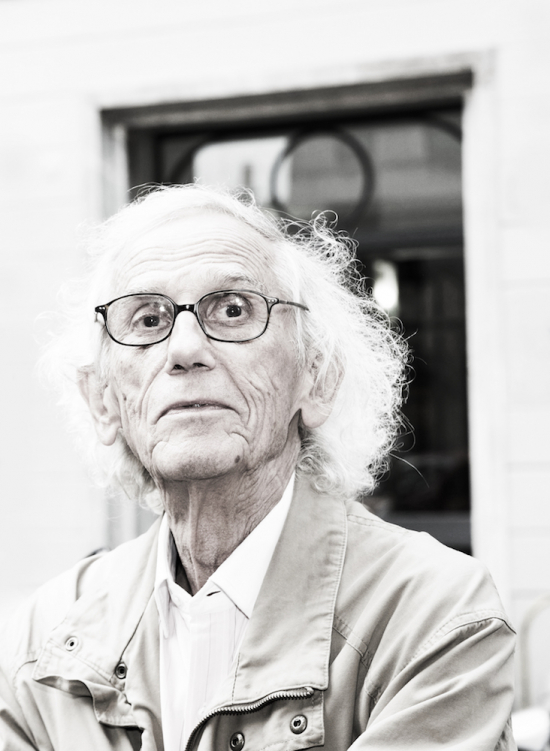THE FLOATING PIERS
by Lina Vergara Huilcamán
A WORK OF ART AND A PRESENT BY CHRISTO AND JEANNE-CLAUDE.
“From June 18 to July 3, 2016, weather permitting, Italy’s Lake Iseo will be reimagined. 70,000 square meters (83,719 square yards) of shimmering yellow fabric, carried by a modular floating dock system of 200,000 high-density polyethylene cubes, will undulate with the movement of the waves as The Floating Piers rise just above the surface of the water. Visitors will experience this work of art by walking on it from Sulzano to Monte Isola and to the island of San Paolo, which it encircles. The mountains surrounding the lake will offer a bird’s-eye view of The Floating Piers, exposing unnoticed angles and altering perspectives. A 3-kilometer-long walkway will be created as The Floating Piers extend across the water of Lake Iseo. The piers will be 16 meters (52 feet) wide and approximately 50 centimeters (20 inches) high with sloping sides. The fabric will continue along 1.5 kilometers (3,937 feet) of pedestrian streets in Sulzano and Peschiera Maraglio. […] The Floating Piers will be Christo’s first large-scale project since Christo and Jeanne-Claude realized The Gates in 2005. As with all of Christo and Jeanne-Claude’s projects, The Floating Piers will be funded entirely through the sale of Christo’s original works of art. After the 16-day exhibition, all components will be removed and industrially recycled.”*
CHRISTO AND JEANNE-CLAUDE. “THE WORK OF ART IS A SCREAM OF FREEDOM.”
Reading about Christo and Jeanne-Claude’s work of art, trying to answer the questions we all have asked – and keep asking – ourselves each time we learn about their projects (why? what is the point of all this? so much work just to fold everything up in the end and take it away?) I imagined to visit and experience their art in my flesh. For a few moments, as I looked at the pictures and read their descriptions, I especially experienced Wrapped Trees, Fondation Beyeler and Berower Park, Riehen, Basel, Switzerland, 1997–98 and The Gates, Central Park, New York City, 1979–2005. I felt the light of the day and the silence of the night flood everything and flood me as well. I came into contact with all the weird agents that you meet when you go out in the open air. colour. light. shadow. humidity. heat. warmth. cold. air… air above all. And I remembered myself as a free girl on this beautiful Planet that moved me each time I met it. And the works and the few words by Christo and Jeanne-Claude made me remember the impulses that drove me to create, and all the times my professors or class mates or my mother asked me to explain them. There wasn’t and there isn’t a reason for them. How could I and how can I articulate an answer to something that grows up and is gestated in complete anarchy and makes me happy? We are so accustomed to explaining and justifying everything, or asking that everything is explained to us, that we are no longer able to give in to the true essence of art. The true essence of creativity and creation. We have lost the ability to be free. To be part of the nature and the world around us.
Why create a shimmering yellow walkway which allows people to walk on the waters of a lake in Northern Italy?
Why make this walkway shoreless and with slightly sloping sides so that the water washes it almost as if it was a beach?
Why leave it open also at night?
Like many other people, I will go and live the experience, no matter how it turns out, in spite of the traffic that there most likely will be, the unexpected situations that may occur because of my children or my mother, the crowds and the noise that I may find… today, through the sketches of the project, and the opinion I have formed of it, I have already experienced my private Floating Piers. My walkway is completely empty. Just a few anonymous pedestrians. I walk on the still waters of the lake at night and I wait for the dawn and then for the warm sun of the summer. During the shorter night – or the longest day – of the year, I stop in the middle of the water and think about my life, about what I wanted to do and what I have actually done. I think about the story of Christo and Jeanne-Claude and I can’t help thinking about my own story. I think about love. About all the times I didn’t even try to realise an idea, prevented by the common opinion that I would never make it. (too difficult. too absurd.) I look at the blue of the waters as it washes my reality and I see a horizon that I would have never perceived. I sit down and look at the sky above. silence again. water again. yellow again. blue again. A few clouds. Maybe.
There are no questions left for me.
I have learnt the concept of freedom through my senses. I have understood the meaning of my existence. Christo and Jeanne-Claude have given me the freedom to live and dream, to believe that I can create, that I can make all my wishes come true. They have shown me once more, despite her death and his old age, that this is possible. This is the biggest present that I could receive, but most of all it is a present for anybody who wants to walk on the waters of Lake Iseo in June. A present (or a miracle) made through an artwork, which I find worth the name because it conveys the sensation and emotion and feeling that have engendered it to the world.
“Christo’s art is the creation of temporary, beautiful objects on a vast scale for specific outdoor sites. It is in the populist nature of their thinking that they believe people should have intense and memorable experiences of art outside museums.”
– Albert Elsen*
And for those who wonder why these works should be dismantled a few weeks after their installation, although their realisation sometimes took years of work and tenacity and persistence: “All our projects have a very strong nomadic quality, like the nomadic tribes that build their tents, by using this vulnerable material, there is a greater urgency to be seen – because tomorrow it will be gone… nobody can buy those projects, nobody can own them, nobody can commercialize them, nobody can charge tickets to see them, even ourselves, we do not own these works. Our work is about freedom. Freedom is the enemy of possession, and possession is the equal of permanence. This is why the work cannot stay.”
– Christo*
* Passages taken from Christo and Jeanne-Claude by Jacob Baal-Teshuva, Taschen Basic Art.
* Images taken from Christo and Jeanne-Claude. The Floating Piers, Taschen.


